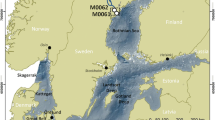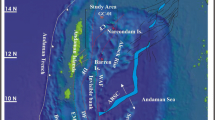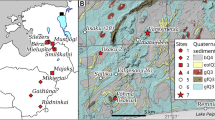Abstract
This study entails the characterization of the depositional environment of the Hupo Basin shelf. By means of sedimentary structure analysis, grain size, textures, sediment color, as well as optically stimulated luminescence (OSL) and accelerator mass spectrometry (AMS) ages, a sediment core (19ESDP-101, 120 m) has been interpreted to be the product of shallow-water contourites. The shallow-water (165 m) contourite deposits observed in the core are divided into seven sedimentary facies grouped into four facies associations (FA): FA1) contourite drift, FA2) contourite drift/channel transition, FA3) contourite channel/drift transition, and FA4) contourite channel. FA1 resulted from the interaction between hemipelagic fallout, low-density gravity flow, and sedimentation under low velocity bottom currents. Compared to FA1, both FA 2 and FA3 are indicative of higher velocity bottom currents, owing to their relative increase in grain size and the presence of subtle indicators of bed-load transport. FA 4 portrayed massive to slightly bedded sand, representing a contourite channel environment with high-energy conditions. Fluctuations in the bottom current activity, related to the intensification and deceleration of the North Korean Cold Current (NKCC), have caused fluctuations between contouritic and hemipelagic-dominated periods. The vertical sedimentary facies stacking patterns observed at the Hupo Basin site suggested that, over time, the depositional processes changed at the site where the core was optained. The facies association stacking pattern suggests the lateral migration of the contourite depositional system and continuous flow of the NKCC. Our findings and interpretations can serve as a much needed reference for shallow-water contourite recognition in modern environments. Moreover, our proposed model can be used to more accurately interpret shallow-water contourite deposits.











Similar content being viewed by others
References
Allen JRL (1984) Parallel lamination developed from upper-stage plane beds: A model based on the larger coherent structures of the turbulent boundary layer. Sediment Geol 39:227–242
Bahk JJ, Han SJ, Khim BK (2004) Variations of terrigeneous sediment supply to the southern slope of the Ulleung Basin, East/Japan Sea since the Last Glacial Maximum. Geosci J 8:381–390
Cho YK, Kim K (1994) Two modes of salinity minimum layer water in the Ulleung Basin. La mer 32:271–278
Chun JH, Kim Y, Bahk JJ, Kim YJ, Kang DH, Kim YH, Kim GY, Ryu BJ (2015) Late Holocene distal mud deposits off the Nakdong delta, SE Korea: evidence for shore-parallel sediment transport in a current-dominated setting. Geo-Mar Lett 35:475–485
de Castro S, Hernández-Molina FJ, de Weger W, Jiménez-Espejo FJ, Rodríguez-Tovar FJ, Mena A, Llave E, Sierro FJ (2021) Contourite characterization and its discrimination from other deep-water deposits in the Gulf of Cadiz contourite depositional system. Sedimentology 68:987–1027
de Castro S, Hernández-Molina FJ, Rodríguez-Tovar FJ, Llave E, Ng ZL, Nishida N, Mena A (2020) Contourites and bottom current reworked sands: Bed facies model and implications. Mar Geol 428:106267
de Weger W, Hernández-Molina FJ, Flecker R, Sierro FJ, Chiarella D, Krijgsman W, Manar MA (2020) Late Miocene contourite channel system reveals intermittent overflow behavior. Geology 48:1194–1199
de Weger W, Hernández-Molina FJ, Miguez-Salas O, de Castro S, Bruno M, Chiarella D, Sierro FJ, Blackbourn G, Manar MA (2021) Contourite depositional system after the exit of a strait: Case study from the late Miocene South Rifian Corridor, Morocco. Sedimentology 68:2996–3032
Faugères JC, Stow DAV (1993) Bottom-current-controlled sedimentation: a synthesis of the contourite problem. Sediment Geol 82:287–297
Gonthier E, Faugères JC, Stow DAV (1984) Contourite facies of the Faro Drift, Gulf of Cadiz. In: Stow DAV, Piper DJW (eds) Fine grained sediments, deep-water processes and facies. Geological Society, London, pp 275–291
Hampton M (1972) The role of subaqueous debris flow in generating turbidity currents. J Sediment Petrol 42:775–793
Hampton M (1975) Competence of fine-grained debris flow. J Sediment Res 45:834–844
Heezen BC, Hollister CD (1964) Deep sea current evidence from abyssal sediments. Mar Geol 1:141–174
Heezen BC, Hollister CD, Ruddiman WF (1966) Shaping of the continental rise by deep geostrophic contour currents. Science 152:502–508
Hesse (1975) Turbiditic and non-turbiditic mudstone of Cretaceous flysch sections of the East Alps and other basins. Sedimentology 22:387–416
Hollister CD (1967) Sediment distribution and deep circulation in the western North Atlantic. Dissertation, Columbia University
Jun CP, Kim CH, Kim Y, Lee SJ (2014) Paleoenvironmental reconstruction of the Hupo Basin using grain size and mineral analysis. J Min Soc Korea 27:159–168
Khim BK, Kim S, Park YH, Lee J, Ha S, Yoo KC (2021) Holocene sedimentation in the Hupo Trough of the southwestern East Sea (Japan Sea) and development of the East Korea Warm Current. The Holocene 31:1148–1157
KHOA (2021) Tidal Table (Coast of Korea). Korea Hydrographic and Oceanographic Administration, Busan
KIGAM (2012) Marine Geological and Geophysical Mapping of the Korean Seas. Korea Institute of Geoscience and Mineral Resources, Daejeon
Kim BK (1984) Cenozoic biostratigraphy of South Korea. Palaeogeogr Palaeoclimatol Palaeoecol 46:85–96
Kim CH, Kim K (1983) Characteristics and origin of the cold water mass along the coast of Korea. J Ocean Soc Korea 18:73–83
Kim GB, Yoon SH, Kim SS, So BD (2018) Transition from buckling to subduction on strike-slip continental margins: Evidence from the East Sea (Japan Sea). Geology 46:603–606
Kim HJ, Jou HT, Yoo HS, Kim KH, You LS (2011) High-resolution seismic imaging of shallow geology offshore of the Korean Peninsula: offshore Uljin. Geophys and Geophys Explor 14:127–132
Kim HJ, Lee GH, Choi DL, Jou HT, Li Z, Zheng Y, Kim GY, Lee SH (2015) Back-arc rifting in the Korea Plateau in the East Sea (Japan Sea) and the separation of the southwestern Japan Arc from the Korean margin. Tectonophysics 638:147–157
Kim HJ, Lee GH, Jou HT, Cho HM, Yoo HS, Park GT, Kim JS (2007) Evolution of the eastern margin of Korea: Constraints on the opening of the East Sea (Japan Sea). Tectonophysics 436:37–55
Kim WH (1990) Significance of early to middle Miocene planktonic foraminiferal biostratigraphy of the E-core in the Pohang Basin, Korea. J Paleontol Soc Korea 6:144–164
Kim YH, Min HS (2008) Seasonal and interannual variability of the North Korean Cold Current in the East Sea reanalysis data. Ocean and Polar Res 30:21–31
Kong GS, Lee CW (2005) Marine reservoir corrections (DR) for southern coastal waters of Korea. J Korean Soc Oceanogr 10:124–128
Kong GS, Park SC (2007) Paleoenvironmental changes and depositional history of the Korea (Tsushima) Strait since the LGM. J Asian Earth Sci 29:84–104
Lee GH, Kim DC, Park MK, Park SC, Kim HJ, Jou HT, Khim BK (2010) Internal reflection pattern of Korea Strait shelf mud (Nakdong River subaqueous delta) off southeast Korea and implications for Holocene relative base-level change. Isl Arc 19:71–85
Lee GR (2014) Geomorphological processes of fluvial terraces at the river basins in the East Coast in the southern Taebaek Mountain Range. J Korean Geogr Soc 1:1–17
Miall AD (1977) A review of the braided river depositional environment. Earth-Sci Rev 13:1–62
Middleton GV, Hampton MA (1976) Subaqueous sediment transport and deposition by sediment gravity flows. In: Stanley DJ, Swift DJP (eds) Marine Sediment Transport and Environmental Management. Wiley, New York, pp 197–218
Park KA, Lee JY, Lee EY, Kim YH, Byun DS (2020) Analysis of misconception on the North Korea Cold Current in secondary-school science and earth science textbooks. J Korean Earth Sci Soc 41:490–503
Park Y, Kang N, Yi B, Lee G, Yoo D (2021) Tectonostratigraphic framework in the eastern Korean continental margin, East Sea: Implication for evolution of the Hupo Basin. Basin Res 00:1–27
Pepe F, Di Donato V, Insinga D, Molisso F, Faraci C, Sacchi M, Dera R, Ferranti L, Passaro S (2018) Seismic stratigraphy of upper Quaternary shallow-water contourite drifts in the Gulf of Taranto (Ionian Sea, southern Italy). Mar Geol 397:79–92
Rebesco M (2005) Sedimentary environments contourites. Encyclopedia of Geology. Elsevier, Oxford, pp 513–527
Rebesco M, Hernández-Molina FJ, van Rooij D, Wåhlin A (2014) Contourites and associated sediments controlled by deep-water circulation processes: state-of-the-art and future considerations. Mar Geol 352:111–154
Reimer PJ, Bard E, Baylies A, Beck JW, Blackwell PG, Bronk Ramsey C, Buck CE, Cheng H, Edwards RL, Friedrich M, Grootes PM, Guilderson TP, Haflidason H, Hajdas I, Hatté C, Heaton TJ, Hoffmann DL, Hogg AG, Hughen KA, Kaiser KF, Kromer B, Manning SW, Niu M, Reimer RW, Richards DA, Scott EM, Southon JR, Staff RA, Turney CSM, van der Plicht J (2013) IntCal13 and Marine13 radiocarbon age calibration curves 0–50,000 years cal BP. Radiocarbon 55:1869–1887
Reineck HE, Singh IB (1980) Depositional Sedimentary Environments, 2nd edn. Springer, Berlin
Roberts AP (2015) Magnetic mineral diagenesis. Earth Sci Rev 151:1–47
Smith ND (1971) Pseudo-planar cross-stratification produced by very low amplitude sand waves. J Sediment Petrol 41:69–73
Stow DAV, Faugères JC (2008) Contourite facies and the facies model. In: Rebesco M, Camerlenghi A (eds) Developments in Sedimentology. Elsevier, Amsterdam, pp 223–256
Stow DAV, Faugères JC, Howe JA, Pudsey CJ, Viana AR (2002) Bottom currents, contourites and deep-sea sediment drifts: current state-of-the-art. Geo SocLondon Mem 22:7–20
Stow DAV, Hernández-Molina FJ, Llave E, Bruno M, García M, Somoza L, Brackenridge RE (2013) The Cadiz Contourite Channel: Sandy contourites, bedforms and dynamic current interaction. Mar Geol 343:99–114
Um IK, Choi MS, Bahk JJ, Chun JH (2017) Provenance of late Quaternary sediments on the southwestern slope of the Ulleung Basin, East/Japan Sea. Quat Int 459:153–164
Vandorpe TP, Van Rooij D, Stow DAV, Henriet JP (2011) Pliocene to recent shallow-water contourite deposits on the shelf and shelf edge off south-western Mallorca, Spain. Geom-Mar Lett 31:391–403
Verdicchio G, Trincardi F (2008) Mediterranean shelf-edge muddy contourites: examples from the Gela and South Adriatic basins. Geo-Mar Lett 28:137–151
Viana AR, Almeida W Jr, Nunes MCV, Bulhőes EM (2007) The economic importance of contourites. In: Viana AR, Rebesco M (eds) Economic and Palaeoceanographic Significance of Contourite Deposits. Geological Society, London, pp 1–23
Viana AR, Faugères JC, Stow DAV (1998) Bottom-current controlled sand deposits: a review from modern shallow to deep water environments. Sediment Geol 115:53–80
Yi S, Hong SH, Yoo DG, Lee GS (2022) Palynostratigraphy indication of the Pliocene-Pleistocene boundary in Hupo Basin of East Sea, offshore Korea. Mar Geophys Res 43:28
Yoon HH, Kim JC, Yoo DG, Jun CP, Lee GS, Hong SH (2021) Multi dating approach of long marine core sediments from the south-eastern continental shelf of Korea: Comparison of SAR OSL, TT-OSL and pIRIR dates. Quat Geochronol submitted
Yoon S (1979) Neogene molluscan fauna of Korea. Mem Geol Soc China 3:125–130
Yoon SH, Chough SK (1995) Regional strike slip in the eastern continental margin of Korea and its tectonic implications for the evolution of Ulleung Basin, East Sea (Sea of Japan). GSA Bull 107:83–97
Yoon SH, Sohn YK, Chough SK (2014) Tectonic, sedimentary, and volcanic evolution of a back-arc basin in the East Sea (Sea of Japan). Mar Geol 352:70–88
Acknowledgements
This study was supported by the research ‘Development of the integrated geophysical survey and real-scale data processing technologies for 3D high-resolution imaging of the marine subsurface (GP2020-023, 22-3312)’ from the Korea Institute of Geoscience and Mineral Resources (KIGAM). This study was also supported by ‘Study on submarine active faults and evaluation of possibility of submarine earthquakes in the southern part of the East Sea, Korea (20180016, 22-9851)’ of the Ministry of Oceans and Fisheries (MOF), Korea. We are grateful to Dr. HH Yoon, Dr. K Park, Dr. S Kim, Dr. YM Kim, Ms. TY Kim for sample analysis. We also thank to anonymous reviewers for their detailed and very constructive reviews that improved the manuscript.
Author information
Authors and Affiliations
Corresponding author
Ethics declarations
Conflict of interest
The authors declare that they have no known competing financial interests or personal relationships that could have appeared to influence the work reported in this paper.
Additional information
Publisher’s Note
Springer Nature remains neutral with regard to jurisdictional claims in published maps and institutional affiliations.
Rights and permissions
Springer Nature or its licensor holds exclusive rights to this article under a publishing agreement with the author(s) or other rightsholder(s); author self-archiving of the accepted manuscript version of this article is solely governed by the terms of such publishing agreement and applicable law.
About this article
Cite this article
Hong, SH., Yoo, DG., Lee, GS. et al. Late Pliocene to Quaternary sedimentary facies and stratigraphy of shallow-water contourite deposits in the Hupo Basin, East Sea of Korea. Mar Geophys Res 43, 38 (2022). https://doi.org/10.1007/s11001-022-09499-5
Received:
Revised:
Accepted:
Published:
DOI: https://doi.org/10.1007/s11001-022-09499-5




